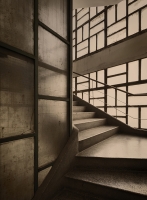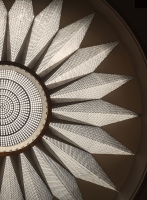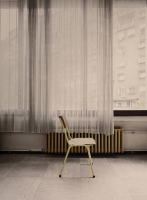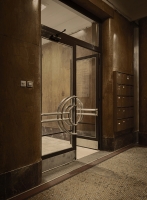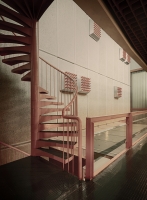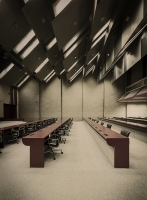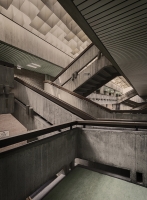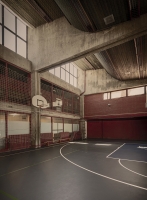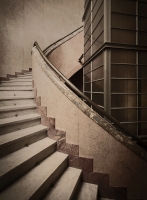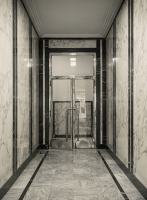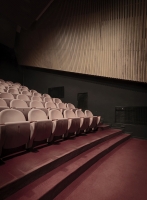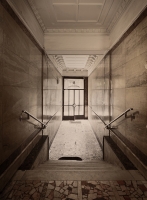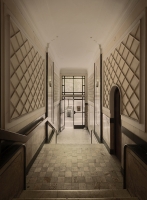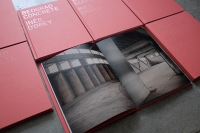Beograd Concrete
Within the scope of Belgrade Photo Month 2021, Inês d’Orey was in an artist residency in the Serbian capital at the Footnote Center for Image and Text, where she developed the series “Beograd Concrete” around the modernist and brutalist architecture present in this region of the world. The residence was supported by the Embassy of Portugal in Serbia.
The research proposed for this residency, which is deeply in line with Inês d'Orey's artistic work, is related to architecture and the identity that this gives to the territory where it operates, as had already happened in other cities such as Lisbon and Porto, Copenhagen or Tokyo. In the case of Belgrade, she was particularly interested in the mixture of styles and architectural references she found in the city, where public buildings built between 1946 and 1980 and other housing or office buildings dating from the First World War, when Yugoslavia was formed, intersect.
In the book of the same name by Inês d'Orey, curator Andreia Garcia says: “In this journey through images, let us understand ourselves as passive subjects, just like the architects of the past, without losing the sense of the gaze, but reinforcing it over the gaze from the photograph that takes away the current and factual point of view about the definition of time, one that does not start from the tabula rasa, that does not go back to zero to understand or write what happens, but rather announces the changes that allow for advancement.”
By crossing recent events in the history of this country, which now has Serbia as its name, it is also possible to understand, or try to understand, the impact that political programs have or can have on the identity and architecture of its cities.
“Beograd Concrete” resultou de uma residência artística em Belgrado, Sérvia, no âmbito do Belgrade Photo Month 2021, na qual Inês d’Orey criou uma série fotográfica que envolve a arquitectura modernista e brutalista presente nesta região do mundo. O conceito da identidade que a arquitectura imprime num determinado território é uma constante no trabalho da artista, o qual já explorou em outras cidades, como Lisboa, Porto, Copenhaga e Tóquio.
No caso de Belgrado, Inês d’Orey interessou-se especialmente na mistura de estilos e referências arquitectónicas que encontrou na cidade, onde edifícios públicos, construídos entre 1946 and 1980 se intersectam com outros edifícios datados durante a Primeira Guerra Mundial, quando a Jugoslavia foi formada.
A fotografia de Inês d’Orey como linguagem, repleta dos seus próprios signos e símbolos, deriva do espaço enquanto objecto arquitectónico e a ele vem a regressar um pouco mais adiante. Há como que uma suspensão do tempo de um lugar mutante, repositório de uma “patine” que parece cristalizar esse momento de ausência temporária da presença humana. Antevemos, pois, que são lugares habitados, ou melhor vividos, calcorreados, num tempo que se retoma, pondo em marcha a história. — Ana Matos, in Folha de Sala
Within the scope of Belgrade Photo Month 2021, Inês d’Orey was in an artist residency in the Serbian capital at the Footnote Center for Image and Text, where she developed the series “Beograd Concrete” around the modernist and brutalist architecture present in this region of the world. The residence was supported by the Embassy of Portugal in Serbia.
The research proposed for this residency, which is deeply in line with Inês d'Orey's artistic work, is related to architecture and the identity that this gives to the territory where it operates, as had already happened in other cities such as Lisbon and Porto, Copenhagen or Tokyo. In the case of Belgrade, she was particularly interested in the mixture of styles and architectural references she found in the city, where public buildings built between 1946 and 1980 and other housing or office buildings dating from the First World War, when Yugoslavia was formed, intersect.
In the book of the same name by Inês d'Orey, curator Andreia Garcia says: “In this journey through images, let us understand ourselves as passive subjects, just like the architects of the past, without losing the sense of the gaze, but reinforcing it over the gaze from the photograph that takes away the current and factual point of view about the definition of time, one that does not start from the tabula rasa, that does not go back to zero to understand or write what happens, but rather announces the changes that allow for advancement.”
By crossing recent events in the history of this country, which now has Serbia as its name, it is also possible to understand, or try to understand, the impact that political programs have or can have on the identity and architecture of its cities.
“Beograd Concrete” resultou de uma residência artística em Belgrado, Sérvia, no âmbito do Belgrade Photo Month 2021, na qual Inês d’Orey criou uma série fotográfica que envolve a arquitectura modernista e brutalista presente nesta região do mundo. O conceito da identidade que a arquitectura imprime num determinado território é uma constante no trabalho da artista, o qual já explorou em outras cidades, como Lisboa, Porto, Copenhaga e Tóquio.
The research proposed for this residency, which is deeply in line with Inês d'Orey's artistic work, is related to architecture and the identity that this gives to the territory where it operates, as had already happened in other cities such as Lisbon and Porto, Copenhagen or Tokyo. In the case of Belgrade, she was particularly interested in the mixture of styles and architectural references she found in the city, where public buildings built between 1946 and 1980 and other housing or office buildings dating from the First World War, when Yugoslavia was formed, intersect.
In the book of the same name by Inês d'Orey, curator Andreia Garcia says: “In this journey through images, let us understand ourselves as passive subjects, just like the architects of the past, without losing the sense of the gaze, but reinforcing it over the gaze from the photograph that takes away the current and factual point of view about the definition of time, one that does not start from the tabula rasa, that does not go back to zero to understand or write what happens, but rather announces the changes that allow for advancement.”
By crossing recent events in the history of this country, which now has Serbia as its name, it is also possible to understand, or try to understand, the impact that political programs have or can have on the identity and architecture of its cities.
“Beograd Concrete” resultou de uma residência artística em Belgrado, Sérvia, no âmbito do Belgrade Photo Month 2021, na qual Inês d’Orey criou uma série fotográfica que envolve a arquitectura modernista e brutalista presente nesta região do mundo. O conceito da identidade que a arquitectura imprime num determinado território é uma constante no trabalho da artista, o qual já explorou em outras cidades, como Lisboa, Porto, Copenhaga e Tóquio.
By crossing recent events in the history of this country, which now has Serbia as its name, it is also possible to understand, or try to understand, the impact that political programs have or can have on the identity and architecture of its cities.



